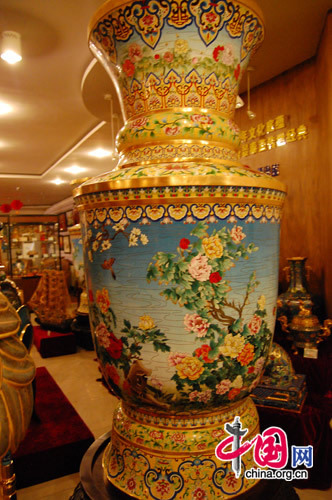Cloisonné, or enamel art, is internationally considered a traditional Chinese art form, but according to Mao Jinfu, manager of the Beijing Enamel Factory, the materials were brought from Europe in the 1300s. Known as Jingtailan in Chinese, and named after Emperor Jing Tai of the Ming Dynasty, Cloisonné was considered a perfect combination of copperware and porcelain, both of which have been very popular in China.
 |
|
The Beijing Enamel Factory puts out roughly 1,500 pieces of Cloisonné every year. Built in 1956, after the founding of the People's Republic of China, the factory also has a shop and historical gallery. [China.org.cn/By Courtney Price]
|
In the Beijing Enamel Factory, it can take up to six months, or even a year to create one piece, though the average is about three months. The art form is used to create a wide variety of works, from chopsticks to vases, and the price varies just as greatly. A pair of chopsticks can be found for as little as 50 yuan, or a little more than US$7, while the most expensive vase in the factory is worth millions.
The creation of one piece is simplified into five general steps: shaping the body, curling the copper wire outlines, filling the design with colored enamel, polishing and gilding. Between most of these steps, the pieces are baked to set the enamel.